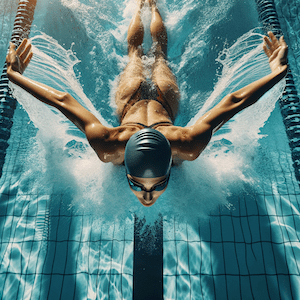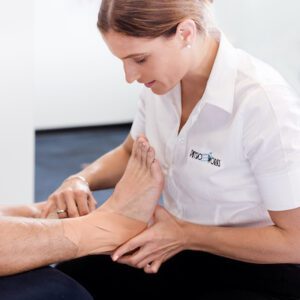
Swimmers Back: Navigating Back Pain in the Pool
Introduction
Swimming, while an excellent form of exercise, can lead to back pain, commonly referred to as “Swimmer’s Back.” This condition, particularly prevalent among butterfly and breaststroke swimmers, warrants understanding and proper management.
Understanding Swimmer’s Back Pain
Swimmer’s Back arises from the spinal stresses unique to swimming, especially in strokes like butterfly and breaststroke. These movements can cause significant strain on the lower back.

Conditions Associated with Swimmer’s Back
Swimmer’s Back is often linked with several specific spinal conditions:
- Spondylolysis: This condition involves a stress fracture in one of the vertebrae in the lower back. It’s common in athletes who engage in sports involving repetitive bending and twisting.
- Spondylolisthesis: This occurs when a vertebra slips forward over the bone below it. It’s often a progression from spondylolysis and can cause lower back pain.
- Degenerative Disc Disease: With this condition, the intervertebral discs, which act as cushions between the vertebrae, start to degenerate, leading to pain and discomfort.
Understanding these conditions and their implications is crucial for swimmers, as they can affect performance and overall spinal health. Preventive measures and appropriate treatments are key to managing these conditions effectively. For more information, it’s beneficial to consult articles specifically addressing:
Prevention Strategies for Swimmer’s Back
To prevent Swimmer’s Back, several key strategies are effective:
- Proper Technique: Mastering correct swimming techniques is vital. This includes understanding the mechanics of different strokes and ensuring body alignment and movement minimise stress on the back.
- Strength and Flexibility: Building core strength and enhancing hip flexibility are crucial. A strong core supports the lower back, reducing the risk of injury, while flexible hips allow for smoother, more efficient movements in the water.
- Physiotherapy Assessments: Regular check-ups with a physiotherapist are recommended. These assessments can provide personalised advice, help in identifying potential issues early, and guide in maintaining optimal spinal health through swimming.
Treatment Approaches for Swimmer’s Back
Effective management of Swimmer’s Back encompasses several key strategies:
- Physiotherapy: This involves customised exercises and manual therapy tailored to the individual’s needs. Exercises often focus on strengthening the core and improving flexibility, while manual therapy might include techniques like massage and mobilisation to alleviate pain and improve function.
- Rest and Recovery: It’s crucial for swimmers to allow sufficient recovery time after intense training sessions. This includes both physical rest and methods like ice or heat therapy, which can help in reducing inflammation and promoting muscle relaxation.
- Training Modifications: Adjusting training routines is essential to reduce back strain. This might involve altering stroke techniques, reducing training intensity, or incorporating cross-training activities to balance muscle use and prevent overuse injuries.
These approaches, combined, offer a holistic path to managing and recovering from Swimmer’s Back, emphasising not just treatment but also prevention and ongoing care.
The Role of Research
Latest research emphasises core stability exercises and hip flexor stretches in preventing and managing back pain in swimmers.
When to Seek Professional Advice
Experiencing back pain while swimming should prompt a consultation with a physiotherapist for a comprehensive assessment and tailored treatment plan.
Conclusion
Managing and preventing Swimmer’s Back requires attention to technique, strength, and flexibility. Professional guidance is key to enjoying swimming while minimising injury risks.
What to Do?
If you’re experiencing discomfort or pain while swimming, it’s vital to seek a physiotherapist’s assessment for appropriate guidance and treatment.
For further insights, consider exploring additional resources on PhysioWorks, such as information on swimming-related injuries and sports physiotherapy.
Related Articles
Article by Zoe Russell
Sports Physiotherapy FAQs


Sports Physiotherapy is the specialised branch of physiotherapy which deals with injuries and issues related to spokespeople. Practitioners with additional formal training within Australia are Sports & Exercise Physiotherapists.
What is Sports Physiotherapy?
Sports injuries do differ from common everyday injuries. Athletes usually require high-level performance and demands placed upon their bodies, which stresses their muscles, joints and bones to the limit. Sports physiotherapists help athletes recover from sporting injuries and provide education and resources to prevent problems. Each sports physiotherapist usually has sport-specific knowledge that addresses acute, chronic and overuse injuries. Their services are generally available to sportsmen and women of all ages engaged in sports at any level of competition.
Members of Sports Physiotherapy Australia (SPA) have experience and knowledge of the latest evidence-based practice, professional assessment and diagnosis of sports injuries, and effective hands-on management techniques and exercise protocols to assist recovery and prevent future damage. SPA members have access to the most recent advances in sports physiotherapy. You'll be pleased to know that most PhysioWorks physiotherapists and massage therapists are particularly interested in sports injury management.
General Sports Physio FAQs
- Sports Physiotherapy
- Acute Sports Injury Clinics
- Sports Physiotherapy Treatment
- Youth Sports Injuries
Injury Management
- Sports Injury? What to do? When?
- When Can You Back to Sport?
- Sports-Related Injuries
- Knee Sports Injuries
- Sports Health Conditions
Sports Massage
Sports Insurance
Related Articles
- Sports Injury Management: This article provides a comprehensive look at how sports injuries are managed, including prevention strategies and treatment options.
- Soft Tissue Injury Healing: Readers can learn about the healing process for soft tissue injuries, including practical advice for each phase of recovery.
- Prehabilitation: Key to Injury-Free Sports Performance: Offers insights into how athletes can prevent injuries before they occur, focusing on strengthening and conditioning practices.
- Athletics Injuries - Comprehensive Physio Guide: A detailed guide on common injuries in athletics and how to treat and prevent them, making it a valuable resource for athletes of all levels.
- Acute Sports Injury Clinic: Highlights the services offered by sports injury clinics, including fast-track assessments and treatments for acute sports injuries.
- Effective Management of Kids Sports Injuries: This guide focuses on the unique aspects of managing sports injuries in children, offering parents and coaches valuable advice on care and prevention.





